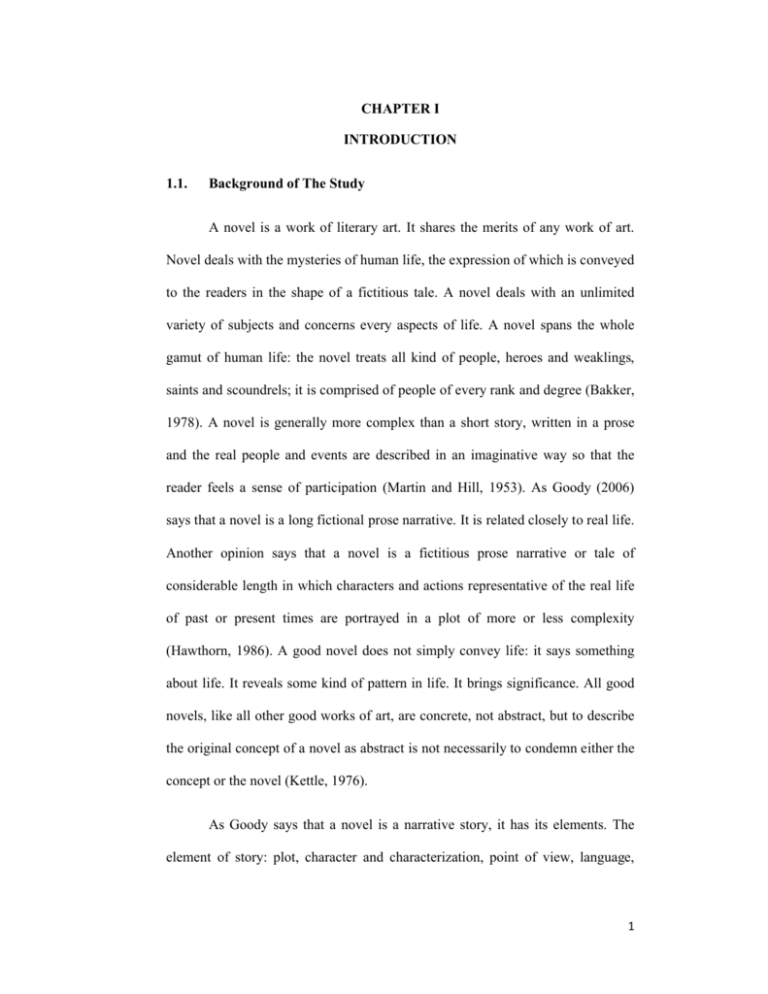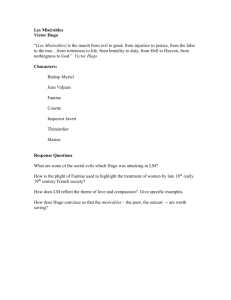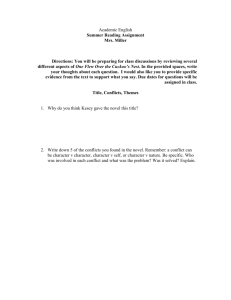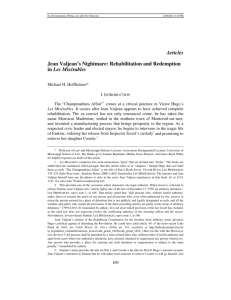- Widya Mandala Catholic University Surabaya
advertisement

CHAPTER I INTRODUCTION 1.1. Background of The Study A novel is a work of literary art. It shares the merits of any work of art. Novel deals with the mysteries of human life, the expression of which is conveyed to the readers in the shape of a fictitious tale. A novel deals with an unlimited variety of subjects and concerns every aspects of life. A novel spans the whole gamut of human life: the novel treats all kind of people, heroes and weaklings, saints and scoundrels; it is comprised of people of every rank and degree (Bakker, 1978). A novel is generally more complex than a short story, written in a prose and the real people and events are described in an imaginative way so that the reader feels a sense of participation (Martin and Hill, 1953). As Goody (2006) says that a novel is a long fictional prose narrative. It is related closely to real life. Another opinion says that a novel is a fictitious prose narrative or tale of considerable length in which characters and actions representative of the real life of past or present times are portrayed in a plot of more or less complexity (Hawthorn, 1986). A good novel does not simply convey life: it says something about life. It reveals some kind of pattern in life. It brings significance. All good novels, like all other good works of art, are concrete, not abstract, but to describe the original concept of a novel as abstract is not necessarily to condemn either the concept or the novel (Kettle, 1976). As Goody says that a novel is a narrative story, it has its elements. The element of story: plot, character and characterization, point of view, language, 1 which can be realistic, symbolic or allegorical, and theme. Conflict is an element of plot (Bonazza, Emil & Sandra, 1982). The basic types of conflict in fiction have been commonly codified as man against man, man against nature, and man against himself (Simpson, 2001). Conflict is also influenced by social environment, economic condition, or even psychological condition. The resolution for each conflict is also different according to who resolves the conflict (Little, 1963). By analyzing the conflict, one can understand the characteristics of the characters, especially the main character. As Shaw (1972:64) states there are three types of conflict: physical, social, and psychological conflicts. The writer considers the external conflict is important to analyze as it brings the important thing to understand the characteristics of a character. External conflicts usually relate to the moral aspect of a character as they occur within the character’s behavior when he faces his opponent. The solution taken by the characters also can be a good example for the readers to learn. The writer takes Victor Hugo’s novel, Les Misérables as the subject to study the external conflicts of the novel’s main character, Jean Valjean. Besides the well-known name of the author, the novel provides many external conflicts among the characters. Therefore, each conflict represents a moral value that will be an advantage for the readers to imitate. By providing various conflicting issues, Les Misérables becomes great novel to be analyzed. (Sims, 2013) In the novel Les Misérables, the writer finds crimes that become something valuable. The writer summarizes the book of Les Misérables as follows: 2 The story took place during French Revolution, where the King, Louis XIV led the government. His authority led poor citizens poorer. Valjean, one of the poor decided to steal a loaf of bread to feed his family. He was arrested by Javert, who was a police at that time, and Valjean was jailed for 19 years. After he was released, Valjean became a great mayor of Montreuil and known as Monsieur Madeleine. He ran factory and started gaining victory. At that time Javert found out that M. Madeleine was Jean Valjean, his ex prisoner. Javert tried hard to arrest Valjean and imprisoned him. The war got more intense from time to time . The first enemy he has to deal with was found within the rebel’s ranks. It was Javert, who was unmasked as a spy and tied up to await execution. Valjean volunteered to execute Javert. Instead, he spared Javert’s life and sent him away. Javert, who felt guilty, decided to commit suicide. Blessing Cosette, his daughter and Marius, one of the young men in the barricade to get married, Valjean revealed his past life to Marius and Cosette. In the end, Valjean died because of his old age. 1.2. Problems The study is an attempt to find out the external conflicts-man vs man of the main character in Victor Hugo’s Les Misérables. The central questions formulated are: 1. What main character’s external conflicts are depicted in this story? 2. What are the causes of the conflicts? 3. What are the solutions to the conflicts? 3 1.3. Objectives Derived directly from the above mentioned problems, the objectives of this study is to find out: (1) the main character’s external conflicts which are depicted in the story, (2) the causes of the conflicts, and (3) the solutions to the conflicts. 1.4. Scope and Limitation of The Study The scope of the study is about the external conflicts of the main character in Victor Hugo’s Les Misérables. The conflict is the one of elements of the novel that makes the main character’s story more interesting. It is focused on the main character’s external conflict as the intrinsic aspects such as characters, plot, and theme. Because the writer only analyzes the main character’s external conflictman vs man, the limitation of this study is that the writer looks at the main character’s conflicts toward his opponents, the causes of the conflicts, and the conflicts’ resolution. 1.5. The Significance of The Study The findings of the study are supposed to give contributions on the area of literature particularly in analyzing the external conflicts of the main character in Victor Hugo’s Les Misérables. The writer expects the findings of this study also give contribution to students of Widya Mandala Catholic University in studying literature. The result of this study, hopefully, will be useful as one of the examples in studying conflicts in a novel. 1.6. Definition of Key Terms External Conflict = is opposition between characters or forces in a work of drama or fiction and an outside force, such as nature and another character (Lamb, 2008). 4 Main Character = is the person or characteristics of person who contributes the most to the story or who is the most important of the story (Bonazza, Emil & Sandra, 1982) Les Misérables = is a French historical novel by Victor Hugo, first published in 1862 by the Penguin Group and in 2012 translated by Norman Denny, student of Radley College. Les Misérables is considered one of the greatest novels of the 19th century (Denny, 2012). 5









